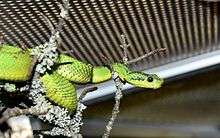Atheris nitschei
| Atheris nitschei | |
|---|---|
 | |
| Scientific classification | |
| Kingdom: | Animalia |
| Phylum: | Chordata |
| Class: | Reptilia |
| Order: | Squamata |
| Suborder: | Serpentes |
| Family: | Viperidae |
| Genus: | Atheris |
| Species: | A. nitschei |
| Binomial name | |
| Atheris nitschei Tornier, 1902 | |
| Synonyms[1] | |
Atheris nitschei is a venomous viper species found in Africa from Uganda and adjacent DR Congo to Rwanda, Tanzania and Burundi.
Taxonomy
The former subspecies Atheris nitschei rungweensis from southwestern Tanzania, northeastern Zambia and northern Malawi was elevated to species rank (Atheris rungweensis).
Etymology
The specific name, nitschei, is in honor of German zoologist Hinrich Nitsche (1845–1902).[4]
The 1906 junior synonym, A. woosnami, was in honor of Kenyan game ranger Richard Bowen Woosnam (1880–1915), who later fought in World War I and was killed in action at Gallipoli.[4]
Description
A. nitschei is a relatively large and stout bush viper, growing to an average total length (body + tail) of 63 cm (25 in) and a maximum total length of at least 73 cm (29 in). The males are smaller than the females.
Common names
Common names for A. nitschei include Great Lakes bush viper, Nitsche's bush viper,[2][3] black and green bush viper, Nitsche's tree viper.[5] sedge viper, green viper, bush viper.[6]
Geographic range
A, nitschel is found in forests of the Central African Albertine Rift, in eastern DR Congo, Uganda, western Tanzania, Rwanda, and Burundi.
The type locality is listed as "Mpororosumpf, Deutsch-Ost-Afrika" [Mpororo swamp, Tanzania-Rwanda border].[1]
Habitat
Preferred habitats of A. nitschei are wetland and meadow areas, and elephant grass marshes, along small streams, sometimes in scrub and bush in valleys at higher elevations, and in mountain forests up to the bamboo zone at 1,600–2,800 m (5,200–9,200 ft) altitude. It is common in papyrus reed around small lakes.[3]
See also
- List of viperine species and subspecies
- Viperinae by common name
- Viperinae by taxonomic synonyms
- Snakebite
References
- 1 2 McDiarmid RW, Campbell JA, Touré TA (1999). Snake Species of the World: A Taxonomic and Geographic Reference, Volume 1. Washington, District of Columbia: Herpetologists' League. 511 pp. ISBN 1-893777-00-6 (series). ISBN 1-893777-01-4 (volume).
- 1 2 Spawls S, Branch B (1995). The Dangerous Snakes of Africa. Dubai: Oriental Press / Ralph Curtis Books. 192 pp. ISBN 0-88359-029-8.
- 1 2 3 Mallow D, Ludwig D, Nilson G (2003). True Vipers: Natural History and Toxinology of Old World Vipers. Malabar, Florida: Krieger Publishing Company. 359 pp. ISBN 0-89464-877-2.
- 1 2 Beolens, Bo; Watkins, Michael; Grayson, Michael (2011). The Eponym Dictionary of Reptiles. Baltimore: Johns Hopkins University Press. xiii + 312 pp. ISBN 978-1-4214-0135-5. (Atheris nitschei, p. 191; A. woosnami, p. 289).
- ↑ Mehrtens JM (1987). Living Snakes of the World in Color. New York: Sterling Publishers. 480 pp. ISBN 0-8069-6460-X.
- ↑ Brown JH (1973). Toxicology and Pharmacology of Venoms from Poisonous Snakes. Springfield, Illinois: Charles C. Thomas. 184 pp. LCCCN 73-229. ISBN 0-398-02808-7.
Further reading
- Tornier G (1902). "Herpetologisch Neues aus Deutsch-Ost-Afrika ". Zoologische Jahrbücher. Abtheilung für Systemaik, Geographie und Biologie der Thiere (Jena) 15: 578-590. (Atheris nitschei, new species, pp. 589–590). (in German).
External links
| Wikimedia Commons has media related to Atheris nitschei. |
- Atheris nitschei at the Reptarium.cz Reptile Database. Accessed 9 September 2007.
- Atheris nitschei at The World Of Atheris. Accessed 9 September 2007.
- Video of Atheris nitschei. on YouTube Accessed 29 October 2006.